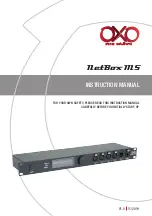
auxiliary fuse to be installed within 18 inches of the
battery.
3.05.4 NOTE: Using smaller input cable
or longer length will greatly degrade the inverter
peak performance.
NOTE FOR VEHICLE INSTALLATION: Do not
use the vehicle chassis as the negative return in
place of a return cable. Use the same size cable
as the positive connection and run directly to the
battery.
3.05.5 Install the cables on the battery,
inverter and then fuse holder. Make sure that
tight, clean connections are made. Use care not
to touch the positive and negative wires together.
This will result in a violent spark and could result
in exploding batteries and fire.
3.05.6
CAUTION: Connecting the inverter
incorrectly to the battery with the polarity re-
versed will cause damage that is not covered
under warranty!
3.05.7 Connect the White cable to the
negative (-) post on the battery. Connect the Red
cable through the fuse to the positive (+) post on
the battery. A mounting spark may result when
connecting the battery wire.
3.06 Remote ON/OFF Switch - Fig. 1
3.06.01 If not used, no connection is
necessary to the violet wire. The remote "On/Off"
feature (violet wire) is not available with the "L"
option.
NOTE: Connecting this wire to chassis ground will
cause damage not covered under warranty!
3.06.2 All material used for the remote
switch should be UL listed and installed per code.
3.06.3 The remote switch should be single
pole, single throw with at least a 1 Amp rating.
The wire used should be at least 18 gauge.
3.06.4 The switch should be mounted at a
convenient location with approved strain relief.
3.06.5 The remote switch should be con-
nected to the violet wire extending from the unit,
using the furnished connector. Connect the wire
to the load side of the switch. Connect the line side
of the remote switch to fused, positive battery.
external AC power source is applied to the inverter’s
AC outlet or its hardwire output.
CAUTION: Be sure both the inverter and the
external AC input circuit breaker or fuse are
turned “OFF” during installation.
NOTE: All wiring must follow the National Electric
Code, Provincial or other codes in effect at the
time of installation, regardless of suggestions in
this manual. All wires should be copper conduc-
tors.
3.03 Mounting
3.03.1 Locate a suitable, secure flat mount-
ing surface as close to the battery as possible
without being in the same compartment. The
maximum recommended distance between the
mounting location and the battery is 20 feet.
3.03.2 The location should have adequate
ventilation and clearance to maintain room tem-
perature while the unit is operating. At least 1/2
inch of clearance is required on all sides.
3.03.3 Secure the unit with #8 or larger
screws or bolts in the mounting slots on the
flanges of the chassis.
3.04 Chassis Bonding Lug - FIG. 1
3.04.1 Connect a #8 gauge or greater cop-
per wire between the bonding lug on the inverter
and the earth grounding system or the vehicle
chassis.
3.05 Battery Wiring - FIG. 1
3.05.1
CAUTION: Make sure that hydrogen
gas does not accumulate near the battery by
keeping the area well ventilated. A spark may
result when connecting the battery wiring due to
an initial charging of the internal input capacitor.
3.05.2 The recommended stranded cop-
per cable gauge between the battery and the
inverter and the necessary line fuse are indicated:
Battery to Inverter Distance (feet)
1-10 11 to 15 16-20
Cable 8 awg 6 awg
6 awg
Fuse 100A 150A 150A
3.05.3 U.L. codes require the use of an
Page
3
























